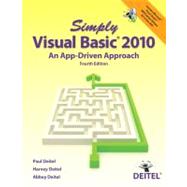For introductory courses in Visual Basic Programming, offered in departments of Information Technology, Computer Science or Business.
Merging the concept of a lab manual with that of a conventional textbook, the Deitels have crafted an innovative approach that enables students to learn programming while having a mentor-like book by their side. This best-seller blends the Deitel™ signature Live-Code™ Approach with their Application-Driven™ methodology.¿ Students learn programming and Visual Basic by working through a set of applications.¿ Each tutorial builds upon previously learned concepts while learning new ones. An abundance of self assessment exercises are available at the end of most chapters to reinforce key ideas.¿
This approach makes it possible to cover a wealth of programming constructs within the Visual Basic 2010 environment.








